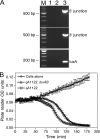Diagnostic bioluminescent phage for detection of Yersinia pestis
- PMID: 19828743
- PMCID: PMC2786668
- DOI: 10.1128/JCM.01533-09
Diagnostic bioluminescent phage for detection of Yersinia pestis
Abstract
Yersinia pestis is the etiological agent of the plague. Because of the disease's inherent communicability, rapid clinical course, and high mortality, it is critical that an outbreak, whether it is natural or deliberate, be detected and diagnosed quickly. The objective of this research was to generate a recombinant luxAB ("light")-tagged reporter phage that can detect Y. pestis by rapidly and specifically conferring a bioluminescent signal response to these cells. The bacterial luxAB reporter genes were integrated into a noncoding region of the CDC plague-diagnostic phage phiA1122 by homologous recombination. The identity and fitness of the recombinant phage were assessed through PCR analysis and lysis assays and functionally verified by the ability to transduce a bioluminescent signal to recipient cells. The reporter phage conferred a bioluminescent phenotype to Y. pestis within 12 min of infection at 28 degrees C. The signal response time and signal strength were dependent on the number of cells present. A positive signal was obtained from 10(2) cells within 60 min. A signal response was not detectable with Escherichia coli, although a weak signal (100-fold lower than that with Y. pestis) was obtained with 1 (of 10) Yersinia enterocolitica strains and 2 (of 10) Yersinia pseudotuberculosis strains at the restrictive temperature. Importantly, serum did not prevent the ability of the reporter phage to infect Y. pestis, nor did it significantly quench the resulting bioluminescent signal. Collectively, the results indicate that the reporter phage displays promise for the rapid and specific diagnostic detection of cultivated Y. pestis isolates or infected clinical specimens.
Figures




References
-
- Advier, M. 1933. Etude d'un bacteriophage antipesteux. Bull. Soc. Path. Exotique. 26:94-99.
-
- Banaiee, N., M. Bobadilla-Del-Valle, S. Bardarov, Jr., P. F. Riska, P. M. Small, A. Ponce-De-Leon, W. R. Jacobs, Jr., G. F. Hatfull, and J. Sifuentes-Osornio. 2001. Luciferase reporter mycobacteriophages for detection, identification, and antibiotic susceptibility testing of Mycobacterium tuberculosis in Mexico. J. Clin. Microbiol. 39:3883-3888. - PMC - PubMed
-
- Brigati, J. R., S. A. Ripp, C. M. Johnson, P. A. Iakova, P. Jegier, and G. S. Sayler. 2007. Bacteriophage-based bioluminescent bioreporter for the detection of Escherichia coli O157:H7. J. Food Prot. 70:1386-1392. - PubMed
-
- Calendar, R., and S. T. Abedon. 2005. The bacteriophages, 2nd ed. Oxford University Press, Oxford, United Kingdom.
Publication types
MeSH terms
Substances
Grants and funding
LinkOut - more resources
Full Text Sources
Other Literature Sources
Medical
Molecular Biology Databases

